Dining on the Road: What Romans Ate While Traveling Across the Empire reveals a vital aspect of ancient life often overlooked—the role of food during long journeys. In the vast expanse of the Roman Empire, travel was frequent and essential for military campaigns, trade, administration, and personal reasons. The ancient Roman diet adapted to these circumstances, reflecting needs for durability, nutrition, and convenience.
Challenges faced by travelers on Roman roads were significant:
- Lack of refrigeration or modern preservation methods
- Limited access to fresh ingredients away from cities
- The necessity for lightweight, non-perishable provisions
- Varied climates affecting food storage and quality
These difficulties shaped the kinds of meals consumed along the way. Travelers and soldiers relied heavily on foods that could withstand extended periods without spoiling while still providing enough sustenance to endure physically demanding journeys.
This article sets out to explore Roman travel food in depth. From staple items like hardtack biscuits to flavorful condiments such as fermented fish sauce, you’ll discover how Romans balanced practicality with their culinary preferences. Understanding what they ate offers insight into daily life and logistics that supported the empire’s movement and expansion.
Staples of Roman Travel Cuisine
One of the most essential preserved Roman foods for travelers and soldiers was buccellatum, often called Roman hardtack. This tough, dry biscuit served as a reliable staple during long journeys and military campaigns. Its durability made it ideal for withstanding various climates and extended periods without spoiling.
Ingredients and Preparation:
- Made primarily from spelt flour mixed with water
- Sometimes included lard to improve texture
- Salt was added both for flavor and preservation
- Baked until extremely hard and dry, creating a cracker-like consistency
Romans consumed buccellatum in two main ways:
- Dry, as a quick snack when on the move
- Soaked in water, wine, or broth to soften its hardness, making it easier to eat
The significance of buccellatum lay in its long shelf life. Non-perishable foods like this were crucial for sustaining energy and nutrition on arduous trips where fresh food was scarce or unavailable. Buccellatum exemplified the practical approach Romans took toward travel cuisine—focusing on preservation and portability without sacrificing basic sustenance.
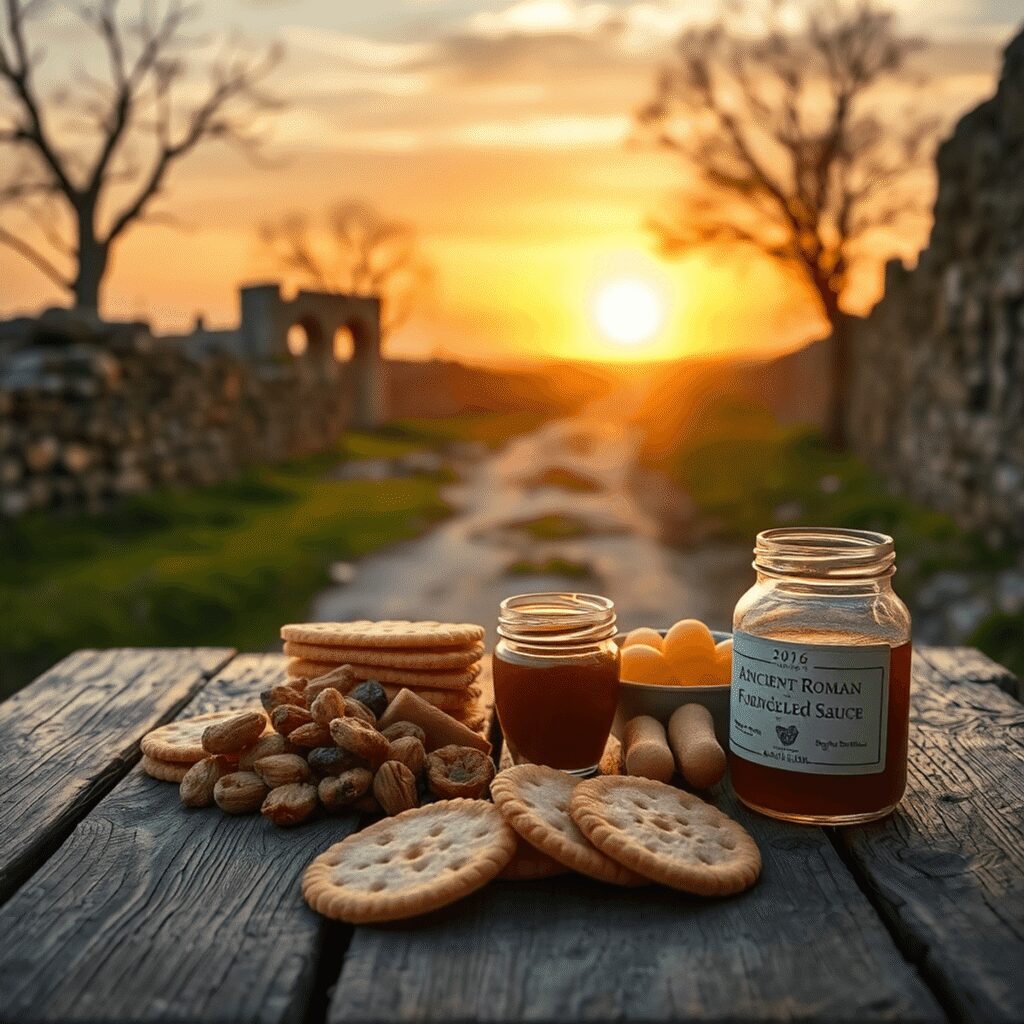
Common Provisions Carried by Roman Soldiers and Travelers
Roman military provisions were designed for durability, nutrition, and ease of transport. Alongside buccellatum, travelers commonly carried:
- Bread: Often freshly baked when possible, but hard breads supplemented rations.
- Wine: Diluted with water to hydrate and provide calories.
- Vinegar: Used both as a preservative and flavor enhancer.
- Lard: A source of fat energy, useful in cooking or spreading on bread.
- Mutton: Salted or preserved meats that could last the journey.
A notable component of Roman travel rations was posca, a sour drink made by mixing water with red-wine vinegar. Soldiers favored posca for several reasons:
“Posca provided hydration with a sharp taste that masked poor water quality while its acidity offered mild antibacterial properties.”
This sour beverage was refreshing and helped maintain health during long marches or campaigns where clean water wasn’t guaranteed. Posca’s simple preparation made it an ideal companion to the staple foods carried.
The combination of these provisions supported endurance by providing a balance of carbohydrates, fats, and protein essential for soldiers and travelers who faced physical exertion daily. Non-perishable items like salted mutton and lard ensured caloric intake even when fresh food sources were scarce. Wine and vinegar not only enhanced flavor but also contributed antiseptic qualities to the diet.
These staples formed the backbone of sustenance on the road, enabling Romans to maintain strength across vast distances within the empire.
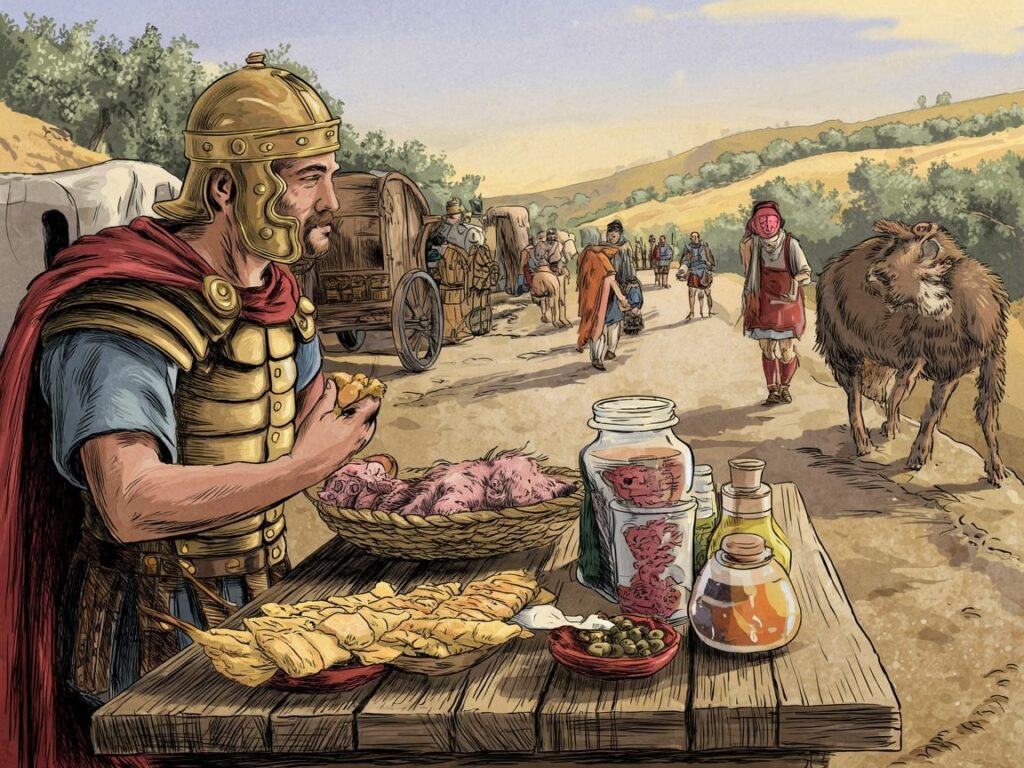
On-the-Go Snacks and Quick Meals
Roman street food offered travelers convenient options that required minimal preparation and could be eaten quickly during long journeys. Two popular portable foods stand out:
1. Fried Dough Snacks
These were easy to carry and provided a rapid source of energy. Made from simple ingredients like flour, water, and sometimes oil or honey, fried dough was crisp on the outside and soft inside. This snack could be eaten plain or dipped in sauces, making it versatile for different tastes while on the move.
2. Meatballs in Ancient Rome
Meatballs were commonly served with flavorful sauces, often tomato-based or seasoned with herbs and garum, the ubiquitous fermented fish sauce. They were a practical choice since they could be prepared beforehand, kept warm, and consumed without utensils. Street vendors frequently sold these as quick meals to hungry travelers or soldiers needing sustenance between stops.
These snacks reflect the Roman approach to dining on the road: practical, filling, and flavorful enough to break the monotony of preserved staples like buccellatum. The availability of such foods also points to bustling roadside markets and urban centers throughout the empire where fresh or freshly cooked items could supplement long-term provisions.
The reliance on portable snacks demonstrates how Romans integrated convenience with taste during travel, ensuring nutrition without sacrificing culinary enjoyment.
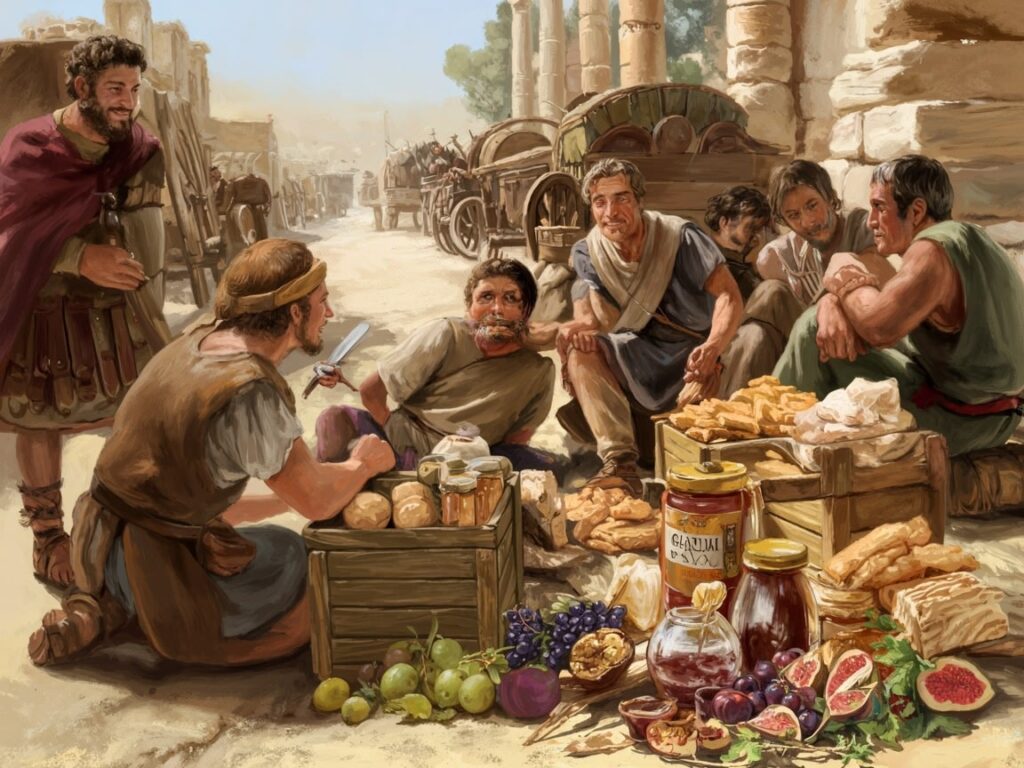
Flavor Enhancers and Condiments on the Road
Romans did not sacrifice flavor when traveling, thanks to Roman condiments that added zest and familiarity to their meals. Two staples stood out: garum sauce and tapenade spread.
1. Garum Sauce
Garum sauce was a fermented fish sauce, produced in coastal factories throughout the empire. It had a pungent aroma but offered a salty, savory umami punch that enhanced even the simplest foods. Travelers carried garum in small containers, using it as a seasoning for bread, meat, or stews. Its long shelf life made it ideal for journeys where fresh ingredients were scarce.
2. Tapenade Spread
Tapenade spread originated from the Mediterranean regions and consisted mainly of crushed capers and olives mixed with herbs and oil. This tangy, salty paste could be easily stored and spread onto hardtack or flatbreads. Tapenade provided a burst of flavor and some nutritional value through healthy fats, making it a welcome addition to bland travel rations.
These condiments helped maintain culinary traditions far from home while addressing practical challenges of food preservation. They transformed basic provisions into satisfying meals that connected Romans to familiar tastes despite the rigors of travel.
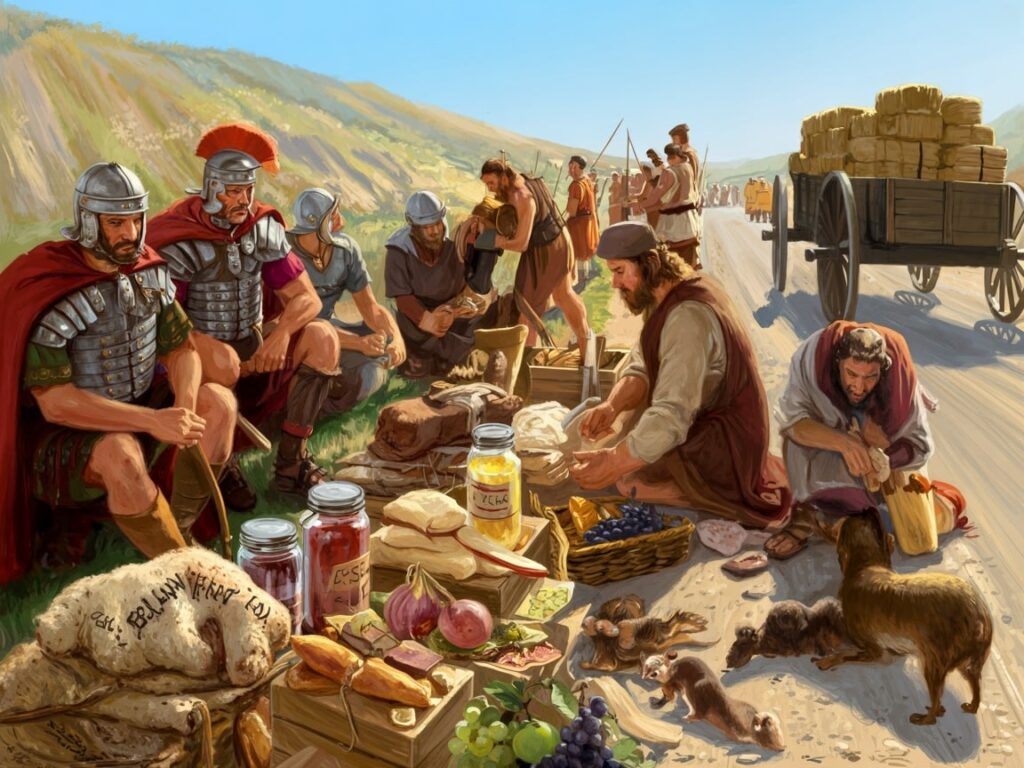
Fresh and Local Foods Encountered During Travel
Roman travelers often took advantage of the fresh local produce offered along their routes. While durable staples like buccellatum and preserved provisions formed the backbone of their diet, access to seasonal foods provided variety and vital nutrients.
Opportunistic consumption of fresh foods included:
- Fruits such as figs, grapes, and apples found in orchards or markets
- Vegetables like cabbages, onions, and leeks grown near settlements
- Wild greens and herbs gathered spontaneously along roadsides
- Fresh fish or shellfish when passing coastal areas or rivers
This approach allowed travelers to supplement their meals with perishable items that were otherwise impractical to carry over long distances. The availability of these foods depended heavily on seasonality and geography, requiring flexibility and local knowledge.
Balancing practicality with traditional culinary tastes meant Romans combined these fresh ingredients with their familiar condiments like garum or tapenade. This maintained a connection to home-cooked flavors even while constantly on the move.
Eating fresh local produce helped prevent dietary monotony and scurvy during extended journeys. It also enabled travelers to experience the diversity within the empire’s vast agricultural landscape — an important aspect of Roman life beyond mere sustenance.
Exotic Foods Reserved for Wealthier Romans
Dining on the road generally meant practical, durable provisions. Yet, exotic Roman foods reveal a fascinating contrast enjoyed by the elite during travel or banquets. These luxurious items symbolized status and indulgence far beyond the everyday diet of common soldiers or merchants.
A Prized Treat: Dormice
A well-known dormice delicacy exemplifies this luxury. Romans bred dormice in special terracotta containers called gliraria to fatten them up. Served stuffed with nuts and honey or seasoned with rich spices, dormice were considered a prized treat. This practice highlights both the lengths to which wealthy Romans went for exclusive flavors and their appreciation for unusual fare.
Other Extravagant Choices
Other extravagant choices included:
- Flamingo: prized for its vibrant color and unique taste, often roasted whole.
- Peacock: served flamboyantly with its feathers sometimes presented at the table.
- Exotic birds like parrots and songbirds featured in elaborate dishes.
The Contrast of Culinary Priorities
Such foods were impractical for lengthy journeys due to perishability and preparation complexity. They sharply contrast with the hardy staples like buccellatum or posca that supported endurance on long travels. Luxury ancient cuisine catered to refined palates seeking novelty rather than sustenance.
This divergence between elite indulgence and traveler practicality reveals much about Roman social structure and culinary priorities during movement across the empire.
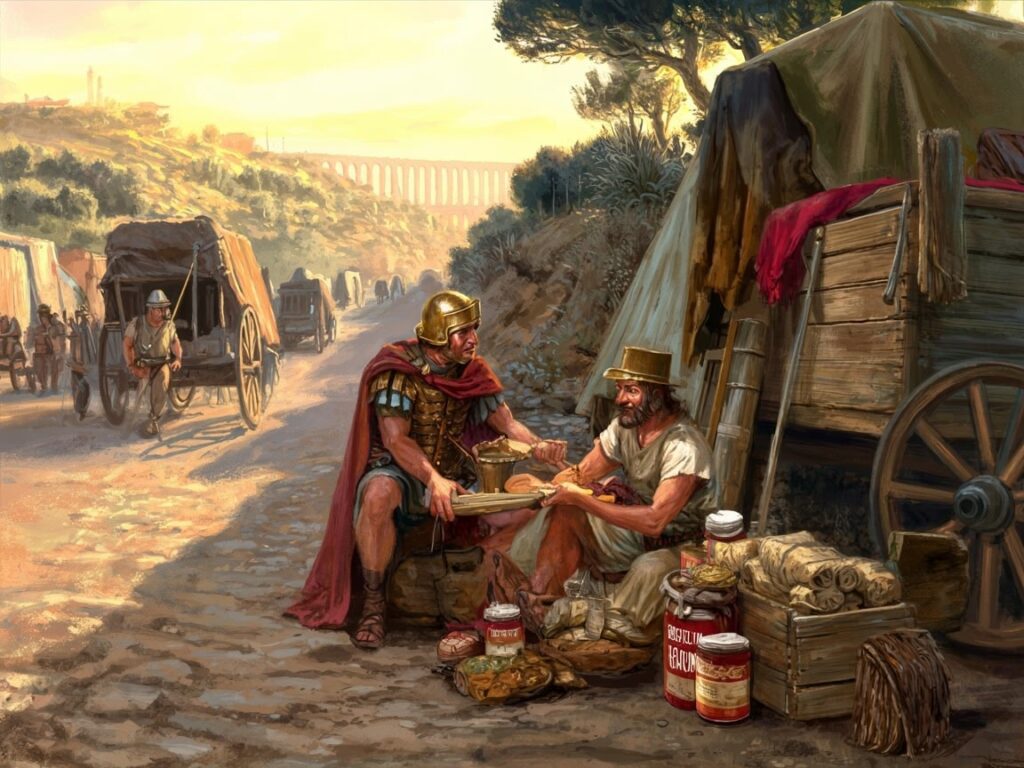
The Balance Between Practicality and Tradition in Roman Travel Diets
Romans were skilled at finding a balance between practicality and culinary tradition when it came to their travel diets. The challenge was to make sure that the foods they brought on long journeys were sturdy enough to withstand the trip, while still being familiar in taste and providing necessary nutrients. This balance was vital for keeping soldiers and travelers energized during extended periods away from home.
How the Roman Diet Achieved Practicality for Travel
Several key factors contributed to the practicality of the Roman diet for travel:
- Durability: Foods like buccellatum (a type of hardtack) and salted meats were resistant to spoilage. These staple foods could withstand harsh conditions without refrigeration, making them dependable sources of energy.
- Nutrition: Even though preserved foods may seem basic, they still offered important calories and nutrients. Lard added fat content, while vinegar-based drinks like posca helped maintain hydration and overall health.
- Culinary preferences: Romans didn’t give up their love for flavorful dishes. They used condiments such as garum (fermented fish sauce) and tapenade (olive spread) to enhance the taste of their meals, even when fresh ingredients were hard to come by.
Ancient Food Preservation Methods Used by Romans
The success of the Roman travel diet relied heavily on ancient methods of preserving food:
- Drying: By removing moisture from bread or meat through drying techniques, Romans slowed down the growth of bacteria and extended the shelf life of these products.
- Fermenting: The process of making garum involved fermentation, which not only preserved the fish sauce but also intensified its umami flavors.
- Salting: Salt played a crucial role in preventing decay by drawing out moisture from meats and vegetables.
These preservation methods ensured that travelers consumed meals that were both practical for their journeys and aligned with Roman culinary customs. They bridged the gap between necessity and tradition, supporting Rome’s extensive network of movement and conquest.
Conclusion
The study of ancient Roman travel culture reveals how essential food was in enabling the vast movement and expansion of the Roman Empire. The dietary practices documented in Dining on the Road: What Romans Ate While Traveling Across the Empire showcase a system built on practicality, nutrition, and adaptability.
Key takeaways include:
- Sustaining armies and travelers required durable staples like buccellatum and posca, ensuring energy and health over long distances.
- Preservation techniques such as drying, fermenting, and vinegar use were vital for maintaining food safety without modern refrigeration.
- The blend of preserved provisions with fresh local foods allowed Romans to maintain familiar flavors while meeting nutritional needs.
- Exotic delicacies highlight social distinctions but were rarely part of the everyday traveler’s diet.
These historical travel diets illustrate a balance between survival and cultural identity that supported Rome’s military campaigns, trade routes, and administrative control. Their legacy informs our understanding of ancient logistics and culinary resilience on the road.

